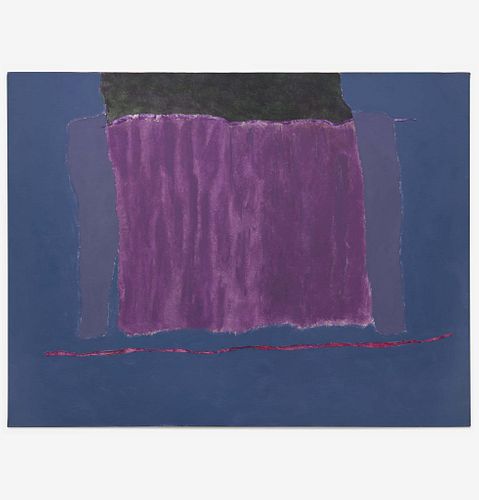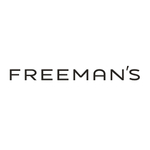Theodoros Stamos (American/Greek, 1922-1997) Infinity Field Lefkada Series
About Seller
2400 Market St
Philadelphia, PA 19147
United States
Established in 1805, Freeman’s Auction House holds tradition close, with a progressive mind-set towards marketing and promotion, along with access to a team of top experts in the auction business. And now with offices in New England, the Southeast, and on the West Coast, it has never been easier to ...Read more
Two ways to bid:
- Leave a max absentee bid and the platform will bid on your behalf up to your maximum bid during the live auction.
- Bid live during the auction and your bids will be submitted real-time to the auctioneer.
Bid Increments
| Price | Bid Increment |
|---|---|
| $0 | $25 |
| $500 | $50 |
| $1,000 | $100 |
| $2,000 | $200 |
| $3,000 | $250 |
| $5,000 | $500 |
| $10,000 | $1,000 |
| $20,000 | $2,000 |
| $30,000 | $2,500 |
| $50,000 | $5,000 |
| $100,000 | $10,000 |
About Auction
Nov 17, 2021
Freeman’s November 17 Modern and Contemporary Art auction offers something for collectors of all stripes, from Pop Art aficionados to connoisseurs of European Early Modernism. Curated by David Weiss, Senior Vice President and Head of Sale for the Modern and Contemporary Art department at Freeman's. Freeman's info@freemansauction.com
- Lot Description
Theodoros Stamos (American/Greek, 1922-1997) Infinity Field Lefkada Series
Signed and dated 1978 on canvas overhang verso, signed again, titled and dated on stretcher bar, acrylic on canvas.
(50 x 66 in. (127 x 167.6cm))Provenance
Private Collection, Philadelphia, Pennsylvania.
Footnote:Note
Part of the first generation of Abstract Expressionists, Theodoros Stamos was one of the youngest members of the “Irascibles Eighteen,” a group of abstract painters in the 1940s who protested the Metropolitan Museum of Art’s policy toward American Art. Working in New York in the 1940s and 1950s, Stamos exhibited his work alongside fellow abstract painters and “Irascibles,” like Jackson Pollock, Willem de Kooning, Mark Rothko, and Robert Motherwell.
Stamos is best known for his subtle abstract compositions, characterized by a broad use of color, broken by lines and soft geometric shapes. He once said of his work, “The great figurative painters were involved with grandeur of vision, using the figure as a means to an end, whereas today the best of the abstract painters are also involved with a grandeur of vision using color as their means toward a new space-light.” [1] Born in New York in 1922 to first generation immigrants, Stamos’s Greek heritage and appreciation for other cultures were important influences on his art. His early works from the 1940s show an interest in natural history, which Stamos expressed through a palette of muted earth-tones and compositions of abstract shapes reminiscent of geologic and organic forms.
From the 1950s on, Stamos took a new approach to abstraction and began creating works as part of series or subseries. For example, his Tea House series from this period consists of simplified compositions of soft geometric shapes with dark calligraphic brushwork, inspired by his interest in travel, East Asian aesthetics and ancient belief systems. His works continued to become increasingly reductive, with focuses on broad, expanding grounds of color and light. Stamos’s Infinity Field Series, which encompasses his works created after 1971, is a series of abstract yet meditative compositions characterized by moody fields of color and light, often broken by slim lines and large shapes. Infinity Field Lefkada Series, created in 1978, is a part of the Infinity Field subseries. The Lefkada subseries was inspired by the Greek islands of the same name, which Stamos frequented from 1970 until his death in 1997.
[1] Marika Herskovic, ed., American Abstract Expressionism of the 1950s: An Illustrated Survey with Artists’ Statements, Artwork, and Biographies, Franklin Lakes, New Jersey: New York School Press, 2003, p. 318.
Condition report:To receive a complete Condition Report on this Lot, please contact the department at modernart@freemansauction.com
- Shipping Info
-
No lot may be removed from Freeman’s premises until the buyer has paid in full the purchase price therefor including Buyer’s Premium or has satisfied such terms that Freeman’s, in its sole discretion, shall require. Subject to the foregoing, all Property shall be paid for and removed by the buyer at his/ her expense within ten (10) days of sale and, if not so removed, may be sold by Freeman’s, or sent by Freeman’s to a third-party storage facility, at the sole risk and charge of the buyer(s), and Freeman’s may prohibit the buyer from participating, directly or indirectly, as a bidder or buyer in any future sale or sales. In addition to other remedies available to Freeman’s by law, Freeman’s reserves the right to impose a late charge of 1.5% per month of the total purchase price on any balance remaining ten (10) days after the day of sale. If Property is not removed by the buyer within ten (10) days, a handling charge of 2% of the total purchase price per month from the tenth day after the sale until removal by the buyer shall be payable to Freeman’s by the buyer. Freeman’s will not be responsible for any loss, damage, theft, or otherwise responsible for any goods left in Freeman’s possession after ten (10) days. If the foregoing conditions or any applicable provisions of law are not complied with, in addition to other remedies available to Freeman’s and the Consignor (including without limitation the right to hold the buyer(s) liable for the bid price) Freeman’s, at its option, may either cancel the sale, retaining as liquidated damages all payments made by the buyer(s), or resell the property. In such event, the buyer(s) shall remain liable for any deficiency in the original purchase price and will also be responsible for all costs, including warehousing, the expense of the ultimate sale, and Freeman’s commission at its regular rates together with all related and incidental charges, including legal fees. Payment is a precondition to removal. Payment shall be by cash, certified check or similar bank draft, or any other method approved by Freeman’s. Checks will not be deemed to constitute payment until cleared. Any exceptions must be made upon Freeman’s written approval of credit prior to sale. In addition, a defaulting buyer will be deemed to have granted and assigned to Freeman’s, a continuing security interest of first priority in any property or money of, or owing to such buyer in Freeman’ possession, and Freeman’s may retain and apply such property or money as collateral security for the obligations due to Freeman’s. Freeman’s shall have all of the rights accorded a secured party under the Pennsylvania Uniform Commercial Code.
-
- Buyer's Premium



 EUR
EUR CAD
CAD AUD
AUD GBP
GBP MXN
MXN HKD
HKD CNY
CNY MYR
MYR SEK
SEK SGD
SGD CHF
CHF THB
THB











